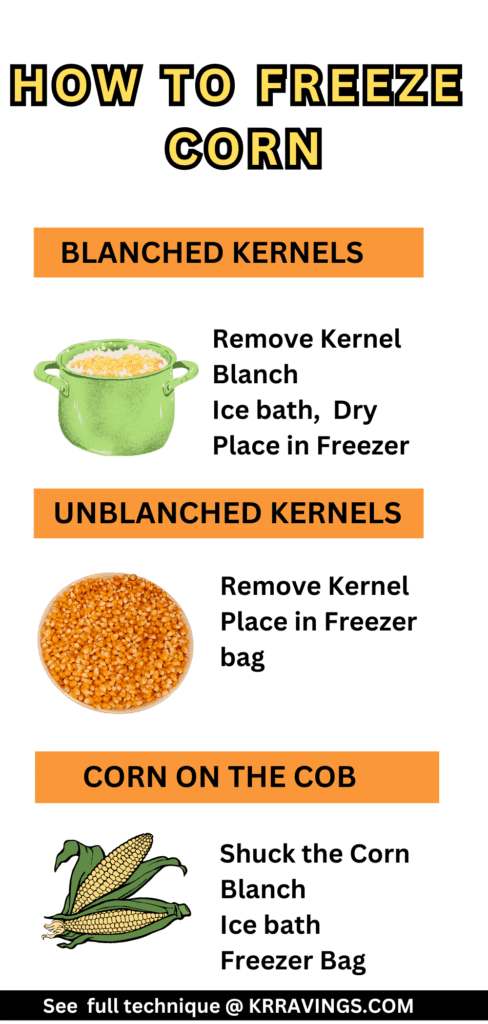This post may contain affiliate links which means I may receive a commission for purchases made through links. Learn more on my Private Policy page.
You may enjoy corn all year long by freezing it, which is a great method to maintain its flavor and sweetness. Freezing is an easy and efficient way to store fresh corn, whether you have a surplus of it in your garden or want to stock up during the busy season. From choosing the best ears to storing them correctly, this tutorial will show you how to freeze corn. You’ll know all you need to freeze corn like an expert by the end of this essay.

Selecting the Best Corn for Freezing
Choosing the appropriate ears is the first stage in freezing corn. Select fresh corn that is at its peak of ripeness for optimal results. Seek for ears with tightly wound, brilliant green husks around the kernels. When punctured, the kernels should be plump and creamy, and the silk should feel silky and slightly sticky to the touch. Steer clear of corn with brown or dry husks; these are signs that the corn is beyond its best.
Tips for Choosing Fresh Corn
Check the husks – They should be green and slightly damp, indicating freshness.
Feel the kernels – They should feel firm and full, not shriveled.
Inspect the silk – It should be moist and light brown, not dry or black.
Preparing the Corn for Freezing
The next step is to get your corn ready for freezing after you’ve chosen it. This entails blanching the ears, husking the corn, and extracting the silk. Blanching is an important step because it inhibits the activity of enzymes that can lead to texture, color, and flavor deterioration during storage.
Steps for Preparing Corn
Husk the Corn – Take off each corn ear’s outer husk and silk. To remove the silk, you can use your hands or a vegetable brush.
Blanch the Corn – Lightly boil a big saucepan of water. After placing the corn ears in the boiling water with care, blanch them for four to six minutes. This procedure eliminates microorganisms and helps maintain the quality of the corn.
Chill the Corn – To stop the cooking process, immediately place the blanched corn in a bowl of ice water. For the same length of time that it was blanched, keep the corn submerged in the ice water.
Dry the Corn – Take the corn out of the water and pat dry with a fresh towel after it has cooled.
Cutting Corn Off the Cob (Optional)
Corn can be frozen either way, on or off the cob, based on your storage needs and preferences. Corn that has been frozen from the cob is more adaptable for cooking and requires less room.
Cutting Corn Off the Cob – A Guide
Hold the cob upright – Lay the cob vertically on a chopping board.
Slice downward – To extract the kernels, slice downward, cutting as close to the cob as possible using a sharp knife.
Gather the kernels – Gather the kernels and toss the cobs into a bowl.
Freezing the Corn
It’s time to freeze the corn after it’s ready. The quality of the corn must be preserved and freezer burn must be avoided with proper packing.
Procedures for Corn Freezing
Pack the Corn – Put the corn in freezer bags or airtight containers, either with the kernels or on the cob. Before sealing the bags, remove as much air as you can from them.
Mark the Packages – Indicate the contents and date on each bag or container. This makes it easier for you to monitor the corn’s storage duration.
Freeze the Corn – To guarantee that the corn freezes uniformly, place the bags flat in the freezer. They can be stacked to conserve space once they’re frozen.
Storing Frozen Corn
Maintaining the quality of your frozen corn requires proper storage. While corn keeps well in the freezer for up to a year, for maximum flavor and texture, use it within 6 to 8 months of purchase.
Storage Advice
Maintain a constant temperature in the freezer – 0°F (-18°C) is the best temperature to store frozen maize.
Steer clear of frequent temperature changes – This may lead to the formation of ice crystals, which would harm the corn’s texture.
Rotating stock – To make sure you’re always using the freshest corn, start with the older containers.
Thawing and Using Frozen Corn
It’s convenient and simple to use frozen corn in a variety of recipes. Depending on the recipe, you can cook it straight from the freezer or thaw it first.
Refreezing Frozen Corn
In the fridge – To gradually defrost the frozen corn, place it in the refrigerator for a few hours or overnight.
Under cold water – Submerge the sealed bag of corn in a basin of cold water to speed up the thawing process. Up until the corn is thawed, change the water every thirty minutes.
In the microwave – Quickly thaw the corn by using the defrost option on your microwave.
Using Frozen Corn
Salads, soups, stews, casseroles, and more may all be made with frozen corn. It’s a flexible component that gives many recipes a touch of sweetness and texture.
Conclusion
One great technique to keep the taste of summer alive all year long is to freeze corn. You may always enjoy wonderful corn by choosing the best ears, blanching and cooking them appropriately, and storing them properly. Frozen corn is a handy and adaptable kitchen staple, whether you like it on the cob or off. You’ll be able to freeze corn like a pro and always have an ample supply of this wholesome vegetable on hand with these easy methods.
Savor the sweet taste of summer anytime you want by using your frozen corn in a variety of ways!
[…] How to Freeze Corn […]